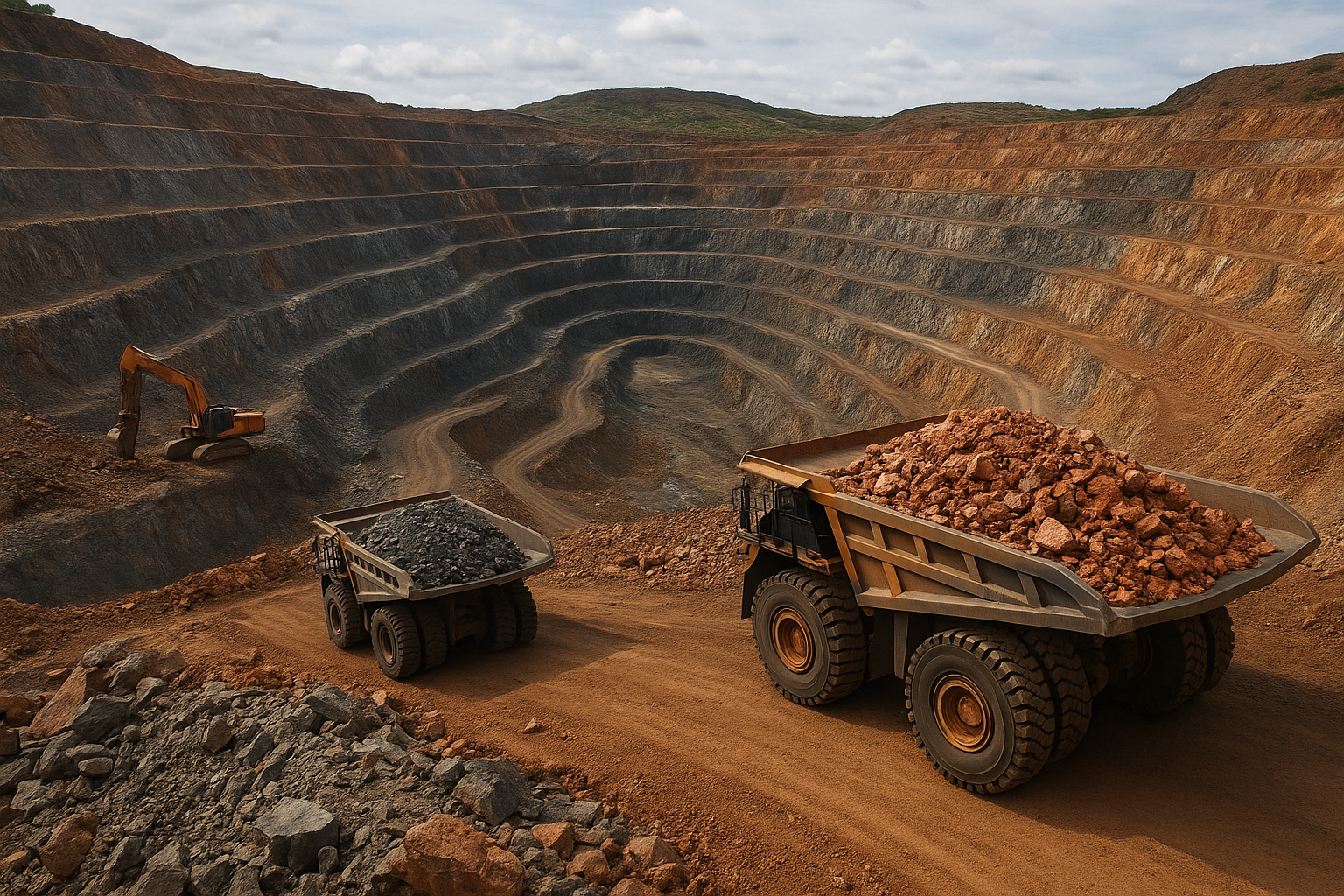For decades, the world’s most strategic materials quietly flowed through one country. From %Cobalt and scandium to rare earths and %Lithium, China built an industrial dominance so complete that it reshaped global manufacturing, defense procurement, and clean-energy policy. It didn’t happen overnight. Through the 1990s and early 2000s, Western nations offloaded mining, refining, and processing capacity in the name of efficiency, comforted by cheap imports and environmental outsourcing. The result: China now mines or processes roughly 90% of the world’s rare-earth metals and a majority of its battery-grade materials.
That era is ending. The gloves are off.
From Quiet Dependence to Economic Crossfire
The roots of today’s confrontation stretch back over forty years. As the U.S. pursued globalization and deregulation, China methodically cultivated control of supply chains critical to modern life from smartphones to fighter jets. In the early 2010s, when Beijing first restricted rare earth exports to Japan amid a maritime dispute, the world received a warning. It wasn’t heeded. Western manufacturers remained content to rely on Chinese supply so long as prices stayed low.
China started the dominoes falling with the weaponization of trade. Tariffs, export bans, and national-security reviews that once seemed extraordinary are now routine. China’s tightening of rare earth export controls this October, adding five more elements to its restricted list, marks the latest escalation. Washington’s response has been equally forceful. The Trump administration’s reinstated tariffs, coupled with new executive orders under the Defense Production Act, signal a long-term decoupling.
“There’s no putting the toothpaste back in the tube,” said Farshad Shirvani, President and CEO of Doubleview Gold Corp. (TSXV: DBG) (OTC: $DBLVF), in a phone conversation on the subject with AllPennyStocks.com. “The U.S. has finally accepted that dependence on adversarial supply chains is a national-security risk.”
A New Industrial Doctrine
The policy shift has triggered a wave of capital formation not seen since the Cold War. JPMorgan Chase recently committed $10 billion to companies deemed essential to U.S. interests, including critical minerals, energy technology, and frontier computing. “It has become painfully clear that the United States has allowed itself to become too reliant on unreliable sources of critical minerals,” CEO Jamie Dimon said in a CNBC article. His words encapsulate a new consensus across finance, defense, and industry: resilience now matters more than efficiency.
Public investment has followed. The U.S. Department of Defense (or War, as it has been rebranded by the Trump administration) and Department of Energy have injected billions into domestic mining and processing ventures, from Alaska to Nevada. As with semiconductors, the goal is not just to reshore production; it’s to rebuild the entire value chain, ensuring that Western allies can access essential materials without passing through Beijing now and for the foreseeable future.
Strategic Players in the Western Revival
A handful of companies now anchor this strategic reindustrialization.
MP Materials (NYSE: $MP), operator of the Mountain Pass Mine in California, has restored America’s rare earth production base from near zero to record levels. Once shuttered and foreign-owned, Mountain Pass now supplies roughly 15% of global rare-earth output and produces neodymium and praseodymium, a product vital for EV motors, drones, and F-35 fighter jets. In just seven years, MP has scaled from restart to fully integrated metal and magnet production, aided by Pentagon and Apple (NASDAQ: AAPL) partnerships that align defense and technology supply chains.
Lithium Americas Corp. (NYSE: $LAC) is doing for lithium what MP did for rare earths. Its Thacker Pass project in Nevada, backed by a $2.23 billion DOE loan and joint venture with General Motors, is poised to become the largest lithium source in North America. Amendments to the DOE loan now grant the federal government a 5% equity stake, reflecting Washington’s new willingness to take direct ownership in strategic materials. Thacker Pass will supply enough battery-grade lithium carbonate for roughly one million EVs per year — a cornerstone of U.S. electrification goals.
Farther north, Trilogy Metals (NYSE: $TMQ) (TSX: TMQ) and its partner South32 have secured a $35.6 million investment from the U.S. Department of War to advance Alaska’s Upper Kobuk Mineral Projects. The government’s 10% ownership and the greenlight for the long-delayed Ambler Road Project underscore a clear objective: unlock Alaska’s vast copper, cobalt, and gallium reserves. The White House has framed the decision as part of “unleashing Alaska’s extraordinary resource potential,” reversing years of permitting gridlock.
Together, these developments reflect a coordinated Western resurgence, not just mining, but strategic autonomy.
Doubleview Gold: Canada’s Quiet Critical Metals Powerhouse
If the United States is rebuilding, Canada is quietly reinforcing the foundation. Doubleview Gold has emerged as one of the most strategically positioned exploration companies in North America. Its flagship Hat Project, located in British Columbia’s mineral-rich Golden Triangle, is a polymetallic porphyry deposit containing copper, gold, cobalt, silver, and critically, scandium, a metal now under Chinese export restriction.
Scandium’s importance is often underestimated: when alloyed with aluminum, it produces lightweight materials used in aircraft, aerospace, EVs, and even high-performance sporting goods due to their strength and light weight. With an estimated 300–500 million tonnes grading 40 ppm Sc₂O₃, Doubleview’s Hat Deposit could represent one of the largest undeveloped scandium resources in the world.
The project’s 2024 NI 43-101 resource estimate confirmed 150 million tonnes indicated at 0.408% CuEq and 477 million tonnes inferred at 0.344% CuEq, containing over 1.35 billion pounds of copper equivalent in indicated resources alone. Equally significant is its accessibility: the Hat is uniquely flat terrain in a mountainous region, requiring minimal new infrastructure, a rarity in the Golden Triangle.
President and CEO Farshad Shirvani, a trained geologist who discovered the deposit in 2014, describes it as “a major Canadian resource discovery with multi-metal potential aligned to modern industry.” The company is advancing toward a Preliminary Economic Assessment, positioning the Hat Project as a scalable, low-impact source of metals vital to clean energy, aerospace, and defense.
The Geopolitical and Market Backdrop
The renewed focus on critical minerals isn’t a transient theme. It represents a structural realignment of global trade, a move from dependency to diversification. China’s latest export restrictions are less a provocation than a declaration of intent: resource control will remain a tool of statecraft. For the West, the response is to build redundancies, alliances, and ownership stakes in every stage of the supply chain.
Projects like MP’s Mountain Pass, LAC’s Thacker Pass, Trilogy’s Upper Kobuk, and Doubleview’s Hat are not isolated ventures; they are nodes in a continental network of strategic independence.
As the world’s two largest economies settle into long-term economic confrontation, the race for materials that power energy systems, weapons platforms, and advanced manufacturing is entering a decisive phase. The winners will be those who control the metals of the future and, increasingly, they’ll be found on North American soil.
—
About AllPennyStocks.com:
Founded in 1999, AllPennyStocks.com Media, Inc. is one of North America’s leading platforms for micro-cap insights.
Catering to both Canadian and U.S. markets, AllPennyStocks.com provides a wealth of resources and expert content designed for everyone, from beginner investors to seasoned traders.
AllPennyStocks.com is rapidly gaining recognition as a leading authority in the micro-cap space, with its content prominently featured across numerous top-tier financial platforms, reaching a broad audience of investors and industry professionals.
Disclaimer / All opinions and information provided above are intended for educational and research purposes only. The information provided above should be used as a starting point for conducting any research on the public companies discussed. All readers should do their own due diligence and research when determining which investment strategies are best suited for them or seek the advice of an investment professional prior to making an investment decision. The profiles of the above discussed public companies are not in any way a solicitation or a recommendation to buy, sell or hold their securities. Doubleview Gold Corp. has initiated AllPennyStocks.com for digital media advertising valued at thirty-nine thousand dollars. Any forward-looking statements set forth in the article above are based on expectations, estimates and projections at the time such statements are made that involve a number of risks and uncertainties which could cause actual results or events to differ materially from those presently anticipated. Forward looking statements may be identified through the use of words such as “projects,” “foresees” “expects,” “will,” “anticipates,” “estimates,” “believes,” “understands” or by statements indicating certain actions “may,” “could” or “might” occur. There is no guarantee past performance will be indicative of future results or that any such forward-looking projections will occur.
For a complete disclaimer, investors are encouraged to click here: https://www.allpennystocks.com/disclaimer/.





